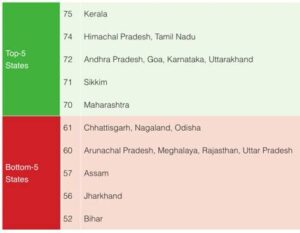In news- The third edition of the SDG India Index and Dashboard 2020–21 was released by NITI Aayog recently.
About the index-
- The report is titled, ‘SDG India Index and Dashboard 2020–21: Partnerships in the Decade of Action’.
- It is designed and developed by NITI Aayog with extensive consultations with the primary stakeholders — the States and Union Territories, UN agencies led by United Nations in India, Ministry of Statistics and Programme Implementation (MoSPI) and the key Union Ministries.
- 13 Goals with 62 indicators were covered in its first edition in 2018, whereas the third edition covers 16 Goals on 115 quantitative indicators that are aligned to MoSPI’s National Indicator Framework (NIF) with a qualitative assessment on Goal 17.

- The SDG India Index computes goal-wise scores on the 16 SDGs for each State and Union Territory.
- These scores range between 0–100, and if a State/UT achieves a score of 100, it signifies it has achieved the 2030 targets.
- The higher the score of a State/UT, the greater the distance to target achieved.
States and Union Territories are classified as below based on their SDG India Index score:
- Aspirant: 0–49
- Performer: 50–64
- Front-Runner: 65–99
- Achiever: 100
- In 2020-21, the country’s overall SDG score improved by 6 points, from 60 in 2019 to 66 in 2020–21.
- This positive stride is largely driven by exemplary country-wide performance in Goal 6 (Clean Water and Sanitation) and Goal 7(Affordable and Clean Energy), where the composite Goal scores are 83 and 92, respectively.

- While in 2019, ten States/UTs belonged to the category of Front-Runners (score in the range 65–99, including both) twelve more States/UTs found themselves in this category in 2020–21.
- Uttarakhand, Gujarat, Maharashtra, Mizoram, Punjab, Haryana, Tripura, Delhi, Lakshadweep, Andaman and Nicobar Islands, Jammu and Kashmir and Ladakh graduated to the category of Front-Runners (scores between 65 and 99, including both).
















